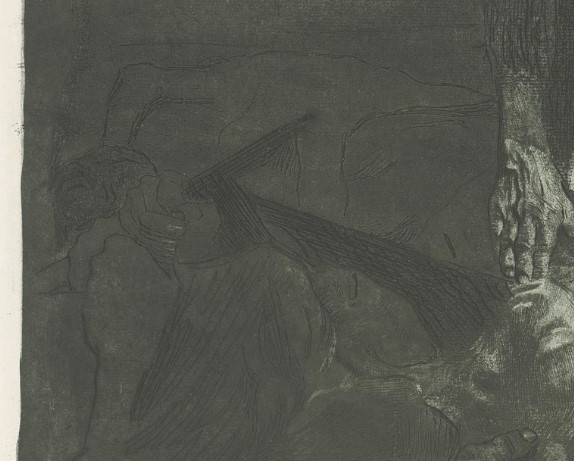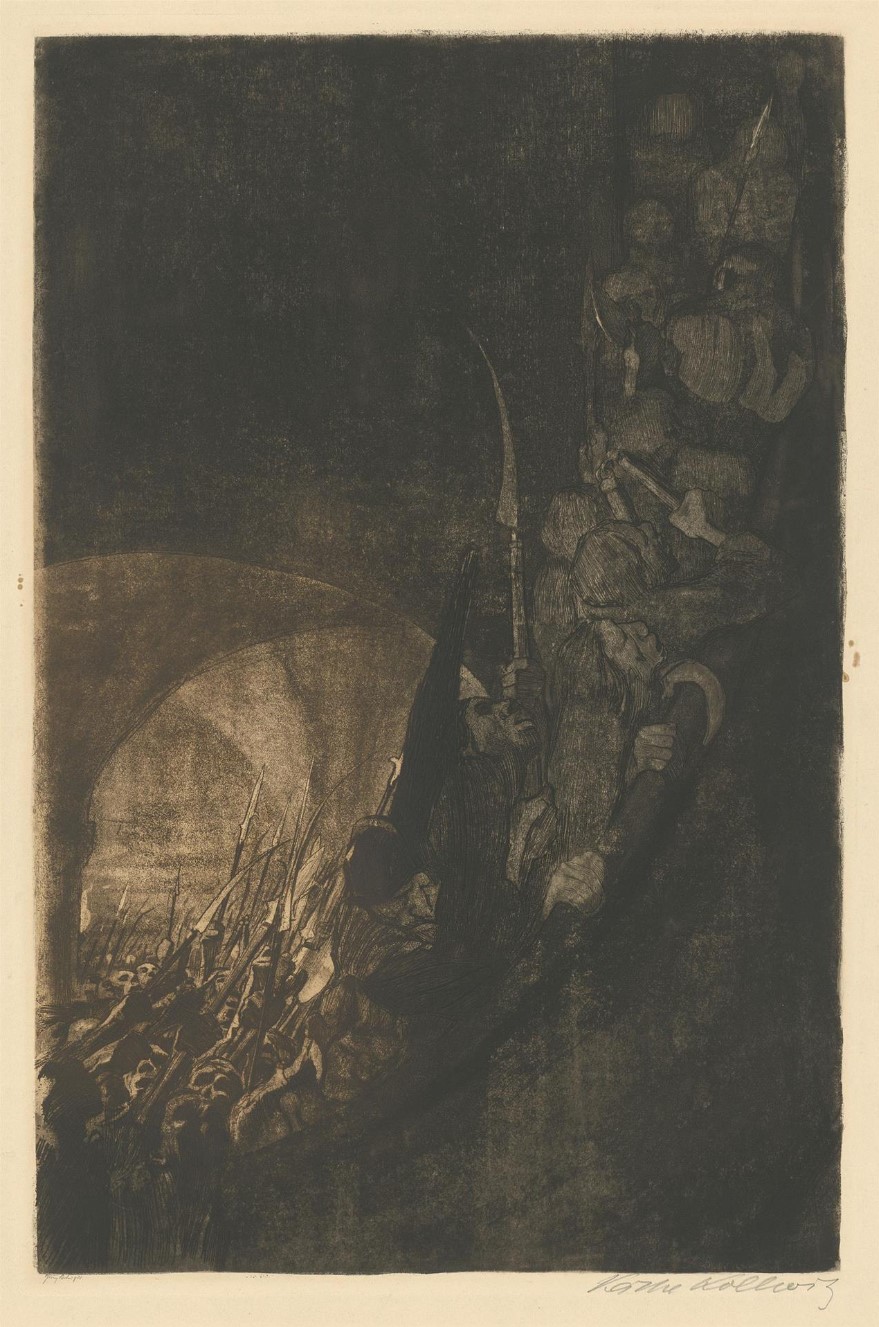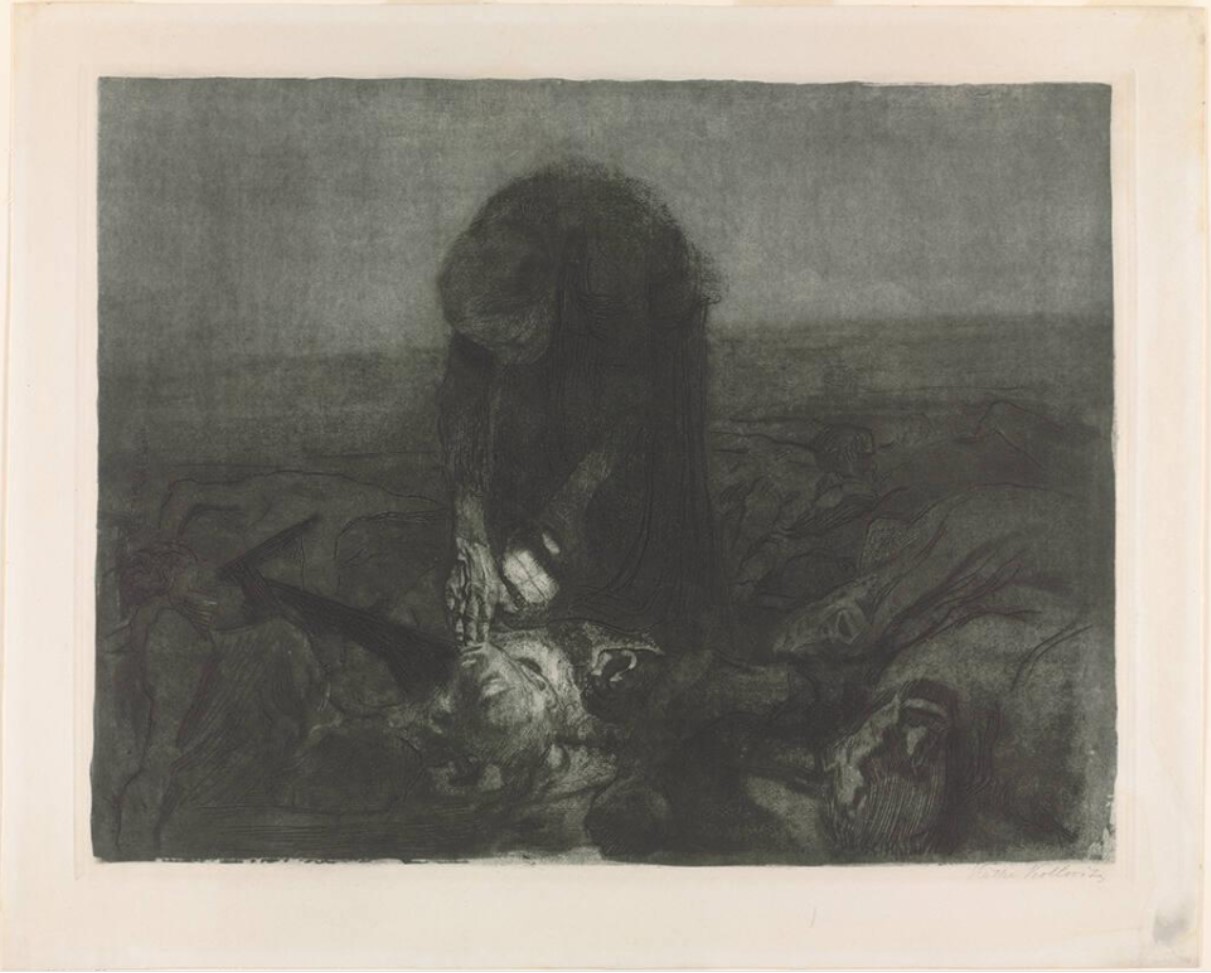BONUS EP ONE PRINT: Kollwitz, Battlefield
Platemark hosts Ann Shafer and Tru Ludwig offer up a bonus HoP episode featuring a conversation about a single work of art. Occasionally we will drop a BONUS EP ONE PRINT, which will take a single work and pull it apart with an eye toward exploring...
Platemark hosts Ann Shafer and Tru Ludwig offer up a bonus HoP episode featuring a conversation about a single work of art. Occasionally we will drop a BONUS EP ONE PRINT, which will take a single work and pull it apart with an eye toward exploring subject matter, technique, style, and composition. The first of these episodes features the etching Battlefield, 1907, by Käthe Kollwitz.
We hope this new kind of conversation resonates, and we’d love to hear your feedback and suggestions for other great prints worthy of a 90-minute episode.
Fun fact: Käthe is pronounced KAY-tuh, not Cathy; in Kollwitz, the W sounds like a V.
Episode image: Käthe Kollwitz (German, 1867–1945). Battlefield, no. 6 from the series Peasants War, 1907. Etching, drypoint, aquatint, sandpaper and softground etching. Plate: 16 ¼ x 20 7/8 in. (41.28 x 53 cm.). Käthe Kollwitz Museum, Cologne.
Pierre-August Renoir. (French, 1841–1919). Luncheon of the Boating Party, 1881. Oil on canvas, The Phillips Collection, Washington, D.C.
John Constable (English, 1776–1837). The Hay Wain, 1821. Oil on canvas. 130.2 × 185.4 cm. National Gallery, London.
Wassily Kandinsky (Russian, 1866–1944). Composition IV, 1911. Oil on canvas. 62.8 × 98.6 in. (159.5 × 250.5 cm.). Kunstsammlung Nordrhein-Westfallen, Düsseldorf.
Käthe Kollwitz (German, 1867–1945). Battlefield, no. 6 from the series Peasants War, 1907. Etching, drypoint, aquatint, sandpaper and softground etching. Plate: 16 ¼ x 20 7/8 in. (41.28 x 53 cm.). Käthe Kollwitz Museum, Cologne.
Jackson Pollock (American, 1912–1956). Number 1, 1950 (Lavender Mist), 1050. Oil, enamel, and aluminum on canvas. 221 x 299.7 cm (87 x 118 in.). National Gallery of Art, Washington, DC.
Marcel Duchamp (American, born France, 1887–1968). The Bride Stripped Bare by Her Bachelors, Even (Large Glass), 1915–23. Oil, varnish, lead foil, lead wire, and dust on two glass panels. 9 ‘ 1 ¼” × 70” x 3 3/8” (277.5 × 177.8 × 8.6 cm). Philadelphia Museum of Art, Philadelphia.
Rembrandt (Dutch, 1606–1669). Militia Company of District II under the Command of Captain Frans Banninck Cocq, also known as The Shooting Company of Frans Banning Cocq and Willem van Ruytenburch (commonly known as The Night Watch), 1642. Oil on canvas. 437 x 363 cm. City of Amsterdam.
Henri Matisse (French, 1869–1954). The Blue Nude (Memory of Biskra), 1907. Oil on canvas. 36 1/4 x 55 1/4 in. (92.1 x 140.3 cm.). Baltimore Museum of Art, Baltimore.
Mark Rothko (American, 1903–1970). No. 17, 1957. Oil on canvas. 232.5 x 176.5 cm. (91.5 x 69.5 in.). Christies.
[DETAIL] Käthe Kollwitz (German, 1867–1945). Battlefield, no. 6 from the series Peasants War, 1907. Etching, drypoint, aquatint, sandpaper and softground etching. Plate: 16 ¼ x 20 7/8 in. (41.28 x 53 cm.). Käthe Kollwitz Museum, Cologne.
[DETAIL] Käthe Kollwitz (German, 1867–1945). Battlefield, no. 6 from the series Peasants War, 1907. Etching, drypoint, aquatint, sandpaper and softground etching. Plate: 16 ¼ x 20 7/8 in. (41.28 x 53 cm.). Käthe Kollwitz Museum, Cologne.
[DETAIL] Käthe Kollwitz (German, 1867–1945). Battlefield, no. 6 from the series Peasants War, 1907. Etching, drypoint, aquatint, sandpaper and softground etching. Plate: 16 ¼ x 20 7/8 in. (41.28 x 53 cm.). Käthe Kollwitz Museum, Cologne.
[DETAIL] Käthe Kollwitz (German, 1867–1945). Battlefield, no. 6 from the series Peasants War, 1907. Etching, drypoint, aquatint, sandpaper and softground etching. Plate: 16 ¼ x 20 7/8 in. (41.28 x 53 cm.). Käthe Kollwitz Museum, Cologne.
[DETAIL] Käthe Kollwitz (German, 1867–1945). Battlefield, no. 6 from the series Peasants War, 1907. Etching, drypoint, aquatint, sandpaper and softground etching. Plate: 16 ¼ x 20 7/8 in. (41.28 x 53 cm.). Käthe Kollwitz Museum, Cologne.
[DETAIL] Käthe Kollwitz (German, 1867–1945). Battlefield, no. 6 from the series Peasants War, 1907. Etching, drypoint, aquatint, sandpaper and softground etching. Plate: 16 ¼ x 20 7/8 in. (41.28 x 53 cm.). Käthe Kollwitz Museum, Cologne.
[DETAILS] Käthe Kollwitz (German, 1867–1945). Battlefield, no. 6 from the series Peasants War, 1907. Etching, drypoint, aquatint, sandpaper and softground etching. Plate: 16 ¼ x 20 7/8 in. (41.28 x 53 cm.). Käthe Kollwitz Museum, Cologne.
Käthe Kollwitz (German, 1867–1945). The Ploughmen, no. 1 from the series Peasants War, 1907. Etching, drypoint, aquatint, sandpaper and softground etching. Plate: 31.5 x 45.7 cm (12 3/8 x 18 in.). Käthe Kollwitz Museum, Cologne.
Käthe Kollwitz (German, 1867–1945). Raped, no. 2 from the series Peasants War, 1907–08. Etching, drypoint, sandpaper and softground etching. Plate: 308 x 529 mm. (12 1/8 x 20 13/16 in.). Käthe Kollwitz Museum, Cologne.
Käthe Kollwitz (German, 1867–1945). Sharpening the Scythe, no. 3 from the series Peasants War, 1908. Etching, drypoint, aquatint, sandpaper and softground etching. Plate: 11 3/4 × 11 11/16 inches (29.8 × 29.7 cm). Käthe Kollwitz Museum, Cologne.
Käthe Kollwitz (German, 1867–1945). Arming the Vault, no. 4 from the series Peasants War, 1906. Etching, drypoint, aquatint, and softground etching. Plate: 19 1/2 x 12 7/8 in. Käthe Kollwitz Museum, Cologne.
Käthe Kollwitz (German, 1867–1945). Charge, no. 5 from the series Peasants War, 1902–03. Etching, drypoint, and softground etching. Plate: (49.2 x 57.5 cm.). Käthe Kollwitz Museum, Cologne.
[DETAIL] Käthe Kollwitz (German, 1867–1945). Charge, no. 5 from the series Peasants War, 1902–03. Etching, drypoint, and softground etching. Plate: (49.2 x 57.5 cm.). Käthe Kollwitz Museum, Cologne.
[DETAIL] Käthe Kollwitz (German, 1867–1945). Charge, no. 5 from the series Peasants War, 1902–03. Etching, drypoint, and softground etching. Plate: (49.2 x 57.5 cm.). Käthe Kollwitz Museum, Cologne.
Käthe Kollwitz (German, 1867–1945). The Prisoners, no. 7 from the series Peasants War, 1908. Etching, drypoint, sandpaper and softground etching. Plate: 328 x 426 mm. (12 15/16 x 16 3/4 in.). Käthe Kollwitz Museum, Cologne.
[DETAIL] Käthe Kollwitz (German, 1867–1945). The Prisoners, no. 7 from the series Peasants War, 1908. Etching, drypoint, sandpaper and softground etching. Plate: 328 x 426 mm. (12 15/16 x 16 3/4 in.). Käthe Kollwitz Museum, Cologne.
[DETAIL] Käthe Kollwitz (German, 1867–1945). The Prisoners, no. 7 from the series Peasants War, 1908. Etching, drypoint, sandpaper and softground etching. Plate: 328 x 426 mm. (12 15/16 x 16 3/4 in.). Käthe Kollwitz Museum, Cologne.
Jean-François Millet (French, 1814–1875) The Gleaners, 1957. Oil on canvas. 83.8 × 111.8 cm. (33 × 44 in.). Musée d’Orsay, Paris.
Jean-François Millet (French, 1814–1875). The Gleaners, 1955. Etching. 192 x 253 mm. Rijksmuseum, Amsterdam.
Käthe Kollwitz (German, 1867–1945). Self-Portrait, 1926–36. Bronze. Käthe Kollwitz Museum, Cologne.
Georges Seurat (French, 1859–1891). Landscape, 1876–86. Black Conté crayon. 24.9 × 31.6 cm (9 13/16 × 12 1/2 in.). Art Institute of Chicago, Chicago.
Ernst Barlach (German, 1870–1938). The Avenger, 1914. Bronze. 22.9 x 44.5 x 61 cm. Harvard Art Museums, Cambridge.
Jacques Muron (French, born 1950). Egret, 1996. Engraving on chine collé. Plate: 14 ½ x 3 ¾ in.
[DETAIL] Jacques Muron (French, born 1950). Egret, 1996. Engraving on chine collé. Plate: 14 ½ x 3 ¾ in.
[DETAIL] Jacques Muron (French, born 1950). Egret, 1996. Engraving on chine collé. Plate: 14 ½ x 3 ¾ in.
Mary Cassatt (American, 1844–1926). The Banjo Lesson, c. 1893. Color drypoint and aquatint with monoprint inking. Plate: 29.85 × 23.81 cm (11 3/4 × 9 3/8 in.); sheet: 41.9 x 29.2 cm (16 1/2 x 11 1/2 in.). National Gallery of Art, Washington, DC.
Andrea Mantegna (Italian, c. 1431–1506). Lamentation over the Dead Christ, c. 1483. Tempera on canvas. 680 x 810 mm. Pinacoteca di Brera, Italy.
Käthe Kollwitz (German, 1867–1945). Battlefield, no. 6 from the series Peasants War, 1907. Etching, drypoint, aquatint, sandpaper and softground etching. Plate: 16 ¼ x 20 7/8 in. (41.28 x 53 cm.). Baltimore Museum of Art, Baltimore.
Rembrandt (Dutch, 1606–1669). The Hundred Guilder Print: Christ with the Sick around Him, c. 1648. Etching, drypoint, and engraving on Japanese paper. 280 x 394 mm. Rijksmuseum, Amsterdam.
Platemark is produced by Ann Shafer
Theme music: Michael Diamond
Audio mixing: Dan Fury, Extension Audio
PR and Marketing: Elizabeth Berger, EYB Creates










































